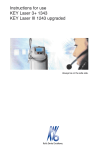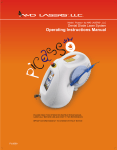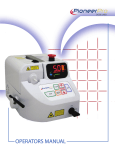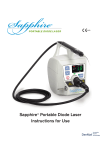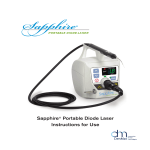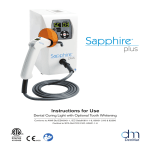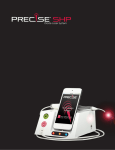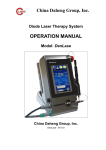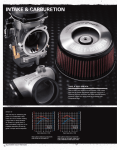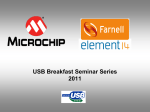Download 1-800-4DenMat www.denmat.com
Transcript
Manufactured for DenMat Holdings, LLC 1017 W. Central Ave. Lompoc, CA 93436 1-800-4DenMat (1-800-433-6628) www.denmat.com ©2014 DenMat Holdings, LLC. All Rights Reserved. 1017 W. Central Ave., Lompoc, CA 93436 756392100 08/14JW CaviWipes is a registered trademark of Metrex Research, LLC. ® SL3 User’s Manual This manual must be read thoroughly and understood prior to using the laser system. CAUTION: Using the controls and adjustments or performing laser procedures, other than as specified herein, may result in hazardous radiation exposure. Table of Contents Section 1: Introduction................................................1 Introduction....................................................................................1 Indications for Use........................................................................1 What’s in the box?.........................................................................1 Section 2: Specifications..............................................2 Laser System Specifications.......................................................2 Laser System Description...........................................................2 LCD Screen.......................................................................................3 Unifiber® System............................................................................3 Section 3: Safety Indications.......................................4 Standards.........................................................................................4 Labels.................................................................................................4 Warnings...........................................................................................4 Precautions......................................................................................5 Protective Eyewear.......................................................................7 Laser System Safety Features....................................................7 Section 4: System Set Up..............................................8 Unpacking........................................................................................8 What’s in the box?.........................................................................8 Installation.......................................................................................8 Cleaning and Disinfection..........................................................10 Transportation................................................................................10 Preparing the Unifiber Hand Piece Assembly.....................11 Section 5: Operation.....................................................12 Procedure Guide............................................................................12 Laser Operation Procedure........................................................13 Section 6: Labels & Symbols .......................................15 Section 7: Warranty and Service.................................16 Service and Maintenance...........................................................16 SL3® Unit Warranty........................................................................16 Compliance......................................................................................18 Section 1: Introduction INTRODUCTION The SL3® diode laser is a Class IV soft-tissue laser that can be used for a wide variety of soft-tissue procedures. This device uses a Gallium, Aluminum, Arsenic (GaAlAS) diode for the active medium, producing laser energy at 808 nanometer wavelength. Laser technology has been steadily evolving, allowing doctors to provide less invasive treatment for many dental procedures, both preventative and restorative. (For a list of approved procedures please refer to page 12.) All of the safety features, warnings and precautions should be observed for the SL3 diode laser. All of the Safety Warning Labels are described in detail on page 15 of this guide. The SL3 diode laser is especially designed to be compact, portable, reliable and user friendly. It provides the practitioner with a versatile instrument for applications ranging from excisions to vaporization of tissues. The diode laser energy is delivered through optical fiber in the hand piece to the removable fiber tips. The system may be utilized for a wide variety of surgical and cosmetic procedures. Indications for Use The SL3 diode laser is intended to be used for oral soft tissue surgery, including: biopsies, hemostatic assistance; treatment of aphthous ulcers; frenectomy; gingival incision and excision; gingivectomy; gingivoplasty; incising and draining of abscesses; operculectomy; removal of fibromas; soft-tissue crown lengthening; sulcular debridement (removal of diseased or inflamed soft tissue in the periodontal pocket) and tissue retraction for impressions. What’s in the box? • Laser • Unifiber® with Hand Piece • Foot Pedal (w/2 AA batteries) • Disposable Tips (10) • Power Adapter • Safety Glasses (3) • Introductory DVD • Caution Sign • Initiating Film • User’s Guide 1 Section 2: Specifications LASER SYSTEM SPECIFICATIONS Size ......................................17.7 cm wide x 13 cm high x 14 cm deep (7” x 5.2” x 5.5”) Weight.................................1.36 kg (3 lbs.) Wavelength ......................808 +/- 10 nm Operation modes ...........Continuous Wave & Pulsed at 10 Hz Output power...................3.0 w ± 20% Pulse width .......................50 ms Calibration.........................External power meter Fiber optic port ...............Standard FT type connector, compatible with 400 μm diameter single-core quartz fiber cable Aiming beam ...................650 ± 10 nm red diode laser, 5 mW maximum Input power .....................Laser Device: 9v , 3.5A / Footswitch: AA Cells, 1.5V Power supply....................100-240 VAC, 1.0 A max, 50-60 Hz, Class 1 Handling/storage............Between 0º – 50º C (32º – 122º F) conditions Protection type................BF part Footpedal protection....IPX1 Laser System Description The laser system is contained within a compact lightweight molded plastic housing, consisting of a laser diode assembly with a self-contained cooling system, a flat LCD screen connected to an interface PCB, and power controller PCB. The base system has two physical buttons. The first button is a mechanical ON-OFF button located on the rear left side of the unit. The second power button is a red LASER STOP button located on the left side. The LASER STOP button de-activates all lasing functions and puts the laser in stand-by mode. A warning message will be displayed. Follow the screen instructions to de-activate the warning message. The laser output power is regulated in 30 steps by “plus sign” and “minus sign” buttons. The LCD front panel screen indicates the level of output power (in Watts) delivered from the tip of the 400 μm fiber when in continuous wave (CW) mode. An operator can choose CW or Pulsed operation mode by pressing the CW or “Pulse” button on the LCD screen. 2 The SL3® diode laser uses an internal battery that is recharged when it is plugged in. When fully charged, the battery will last for 30 minutes in continuous use at maximum power. The SL3 diode laser internal battery is not intended to be changed by the operator. The laser energy is activated by a wireless foot pedal. Depressing the foot-switch activates the lasing process, while releasing it stops the process. The diode laser system is highly portable and self-contained with built-in safety features. It is capable of producing the rated output power in a continuous wave mode for more than half an hour without interruption, allowing completion of most surgical procedures. In the pulsed mode, the system delivers pulsed (interrupted) radiation at a repetition rate of 10 Hertz, and a pulse width of 50 ms. The SL3 diode laser uses disposable, removable fiber-tips to accurately deliver the laser energy. Please refer to page 11 for more information on the disposable tips. LCD Screen The SL3 diode laser is equipped with a touch screen, allowing the user to perform selections of various settings. The screen graphics are intuitive, allowing the user to select options quickly and easily. An example of the main touch screen display is shown in the pictures below. For a complete list of all the features on the “Main Display” screen, see page 12. Unifiber® System Flexible fiberoptic cables are the most widely accepted delivery systems for diode laser power. In the diode laser system, the 400 μm diameter single-core quartz fiber is mounted into standard FC connectors. The fiber optic cable is coated in a steel metal, offering superior protection and preventing damage to delicate fibers. The SL3 diode laser uses a Unifiber system to deliver diode laser power. This consists of an autoclavable, aluminum handpiece shell with internal optics. The hand piece is paired with disposable, non-sterile fiber tips that can be easily removed and replaced in between procedures. For information on setting up the unifiber system, please refer to page 11. 3 Section 3: Safety Indications Testing Standards The SL3® diode laser has been tested to the standards applicable to medical lasers including lEC’s: 60825, 60601-1, 60601-1-2, 60601- 2-22, and the Food and Drug Administration’s Laser Performance Standard (21 CFR 1040.10 and 1040.11). Please review all labels prior to using the laser. Familiarity with the American National Standards Institute Z136.3 Document (and/ or Laser Institute Safety Manual) is strongly recommended. Note: The laser must be installed and operated according to CAN/ CSA-Z386-92: Laser safety in health care facilities. The labels on the unit are required under these standards for safety purposes and should not be removed. Labels Caution Laser in Use Each treatment area should have a “Laser in Use” warning sign posted at the entrance to the treatment area. This signage serves to warn people not to enter the treatment area without proper safety eyewear when the laser is in use. CAUTION - The Nominal Ocular Hazard Distance(s), NOHD, as defined by IEC/ EN 60825-1:2007-03 Ed. 2.0 for this device has been determined to be 143.0cm and 93.0mm for the eye and skin respectively. Proper protection and safeguards for the eyes and skin should be in place within these distances of the laser aperture. Class 4 Laser Product................................ 808nm ± 10nm 3.0 Watts Aiming Beam Laser................................... 650nm ± 10nm 5mW max Pulse Duration............................................. 50 ms Beam Divergence....................................... 617 mRad Warnings WARNING: Laser Radiation – Avoid exposure to the eyes or skin from direct or scattered radiation. DO NOT place any part of the body in direct line with the laser beam. WARNING: Use of controls or adjustments or performance of procedures other than those specified herein may result in hazardous radiation exposure. WARNING: Eyewear that protects your eyes from wavelengths other than 808nm do not provide proper protection for use with this laser. Damage to the retina or cornea may be irreparable if exposed to direct, reflected or scattered radiation. Always wear protective eyewear when operating the laser. WARNING: For the safety of the operator, DO NOT use the laser when the fiber is disconnected at the base connection port. 4 WARNING: Never operate the laser without an attached optical fiber to avoid uncontrolled laser radiation. WARNING: This laser system is very sensitive to back reflections into the laser module, which may damage or completely destroy the facet of the laser diode. Never point the focused laser beam vertically on a reflecting surface. WARNING: Laser treatment may result in inadvertent exposure of adjacent tissues. Undue exposure can result in damage to tissue, vessel perforation and bleeding. The practitioner should always set the laser system for minimal exposure to the patient. Optimal parameters for laser surgery may be achieved by starting with the power as low as possible and increasing incrementally as necessary. Power levels affect the precision of cutting, rate of tissue removal and thermal damage to adjacent tissues. WARNING: The laser can ignite non-metallic materials. All combustible materials must be removed from the operations area or should be kept moist during the procedure. WARNING: The laser can ignite preparation solutions containing alcohol, acetone or other solvents. DO NOT leave puddles of preparation solution in the operations area. Vapors may build up under surgical drapes and create a safety hazard. DO NOT place the foot-switch in an area where it may be accidentally depressed. When the laser is not in use, remove the foot switch from the practitioner’s immediate operations area. WARNING: Never use the laser system in the presence of flammable anesthetic gases. The use of laser-safe endotracheal tubes and other laser-safe accessories is recommended. Many materials not normally considered flammable could be ignited in the presence of high oxygen and nitrous gas mixtures. An acute awareness of the buildup of the gases as a hazard should be maintained. WARNING: Avoid tissue splatter on the working end of the disposable tip, as this will create localized heating, which may cause the fiber tip to char and fail. If back splatter occurs, wipe the tip with alcohol gauze. Allow alcohol to evaporate before continuing the lasing process. DO NOT Use any power supply, other than the one supplied by DenMat with your laser. (Part number 041473) Precautions CAUTION: US Federal law restricts this device to sale by or on the order of a physician. DO NOT attempt to operate the laser system with any protective panels removed or if the fiber delivery system is improperly connected. The system is equipped with an interlock device for the protective housing/cover. CAUTION: Do not attempt to remove the cover from the laser chassis for the purpose of repairing the laser. Serious injury from an electrical shock or laser radiation could occur. Removing the cover on the laser chassis will void the warranty. 5 CAUTION: Not using the proper disposable tip may cause damage to the internal components of the laser. CAUTION: Changes or modifications not expressly approved by DenMat could void the product warranty. CAUTION: The remote interlock feature is disabled by default, so the laser is functional. To use this feature, it must be enabled through the “Tools” screen, and additional hardware is required. CAUTION: Avoid prolonged exposure to the laser energy when working in and around the cervical areas of the tooth. Due to the thin layer of enamel in this area, the laser’s energy may be absorbed by the hemoglobin in the pulp in which case pulpal hyperemia may occur. Extended exposure to laser energy could lead to pain and possible pulpal necrosis. CAUTION: Use a high-volume vacuum to remove the laser “plume.” Provide high-filtration masks for all personnel in the treatment area. The laser plume may contain viable tissue particulates. CAUTION: The fiber optic cable is very fragile and can be damaged where it attaches to the rear panel. Please be particularly careful when transporting or placing the unit near protruding objects, so as not to damage the cable. CAUTION: Do not touch the end of the fiber connector or place it on a dusty/ dirty surface prior to connecting to the rear panel. If contamination occurs, wipe the connector end with lint free soft tissue dampened with 75-80% ethanol or isopropyl alcohol. Make sure it’s dry and then attach the connector to the laser port. CAUTION: This device should be protected against unqualified use when not in use. DO limit access to the operation area to personnel who are trained in the principles of laser safety. The laser system has a remote interlock option that can be activated if necessary. DO NOT attempt to defeat the system’s interlock or access the enclosures, as they are designed for your protection. DO NOT attempt repairs of this system. Service and maintenance should only be performed by a qualified SL3® diode laser Service Technician. CAUTION: Avoid inadvertent laser firing. Turn the laser OFF when not in use for an extended period of time. NOTE: As the aiming beam passes down the same delivery system as the working beam it provides a good method of checking the integrity of the delivery system. If the aiming beam spot is not present at the distal end of the delivery system, its intensity is reduced or it looks diffused, this is a possible indication of a damaged delivery system. 6 Protective Eyewear All personnel in the operation area, including the patient, must wear eye protection! Contact lenses are not viable protection. Eye protection must be specific to the wavelength in use (808 +/- 10 nm). All laser safety glasses/goggles have a wavelength for indicated use stamped into the lens or eyepiece. Care must be taken to assure that everyone in the operations area is wearing the appropriate glasses. (Protective eye wear is marked with optical density >10 at 808 nm). The laser beam from a laser diode is usually not visible to the human eye, but it can seriously damage retinal tissue. DO NOT look directly into the laser beam aperture or into the working end of the optical fiber. Reflected laser light may also cause retinal damage. The reflection hazard exists several feet from the reflection point. Avoid aiming the laser beam in the direction of reflective surfaces. Laser System Safety Features The SL3® diode laser provides the following safety features for both the user and the patient: Audible Lasing Signal - An audible signal (high pitch beeping) sounds whenever the activation foot-switch is depressed. (This feature can be adjusted at the Tools section). Laser Firing Delay - There is a brief delay between depressing the foot switch and the onset of laser activation. This allows the user adequate time to react if the foot switch is inadvertently depressed. Software Key Lock - The laser system is equipped with a software key-switch to protect against unqualified use, and cannot be turned ON until the correct password is used. Remote Interlock - The remote interlock feature gives you the option of installing the laser in a dedicated room and be interlocked with the entrance door to the room. In an interlocked installation, the laser shuts off whenever the door is opened, thereby protecting the eyes of the person entering the room. The code to enable the remote interlock is “6 3 2 4”. Once the interlock is activated and the proper hardware is connected, the laser will shut off if the remote interlock sensor is triggered. Press the power button to turn the laser back on. 7 Section 4: System Set Up Unpacking Immediately upon receipt of the SL3® diode laser system, inspect all components for damage and for missing items. Unpack all components carefully and verify the presence of all components on the packing slip. Notify DenMat immediately if there are any missing components. NOTE: Please keep the shipping box during the laser warranty period for possible service, upgrades or returns. What’s in the box? • Laser • Unifiber® with Hand Piece • Foot Pedal (w/2 AA batteries) • Disposable Tips (10) • Power Adapter • Safety Glasses (3) • Introductory DVD • Caution Sign • Initiating Film • User’s Guide Installation Place the laser on a suitable table, cart or shelf. Remove the protective end-cap from the laser port (red or white cap). Remove the plastic cap from the fiber FC connector. Attach the Unifiber system into the laser port by turning it clockwise. Wind the fiber cable in a clockwise direction around the spool behind the LCD screen as shown below. 8 Factory use only Remote interlock Plug the power cord into a standard AC grounded power outlet (100-240 VAC). Connect the power cord to the proper receptacles on the rear of the laser. Please note that the wide, flat connector to the left of the DC outlet is for factory use only. The battery-powered wireless foot pedal is composed of a supporting plastic base that is connected to the pedal. In order to power the food pedal, you must insert the provided AA batteries. Before inserting the batteries, make sure the laser is completely turned off and that the laser is not plugged in. Laser in use Battery low Battery compartment 1.Turn the foot pedal upside down to locate the battery slot 2.Remove the lid and insert the batteries 3.Close the battery lid The foot pedal has two LED indicator lights located on the top surface of the foot pedal. The green LED indicates that the foot pedal is being depressed and the laser is firing. The amber LED light indicates that the foot pedal battery is low and needs to be replaced. NOTE: Keep extra AA batteries in your office inventory because the battery should be replaced after approximately 100 hours of continued operation. NOTE: Some models come with a foot pedal safety shroud (installed separately). 9 Push the power button on the rear of the laser to the ON position. You will be instructed to input a software lock to protect against unqualified use. Using the keypad on screen, type in “1-2-3-4.” You will see a visual verification that the password has been accepted. The panel LCD screen should now read “0.0”. . Cleaning and Disinfection The SL3® diode laser system is not supplied in sterile condition, nor must it be sterilized before use. The disposable plastic tips are supplied non-sterile and should be wiped with CaviWipes®, or similar product, prior to use. There is no re-use or re-sterilization procedure indicated. After a used tip is taken off the handpiece, discard it in an infectious waste container (SHARPS). The aluminum handpiece shell is autoclavable and must be sterilized after each use. We recommend a steam sterilization method, performed at 121º C (250º F) at 103.4 kPa (15 PSI) for a minimum of 20 minutes. NOTE: The LCD screen is not routinely contaminated by the procedure, but the entire front panel should be covered with a protective clear adhesive barrier film, replaceable after each patient. In the event that the screen is touched without protective film, it should be wiped down with CaviWipes (or equivalent product) and re-covered with a new protective plastic cover. Transportation In the event that the laser system is to be relocated (this does not include moving within the facility), place the system into an appropriate shipping carton. 1. Unwind the Unifiber® from the rear panel and disconnect it. Cover all fiber connectors with appropriate end-caps and place the Unifiber into its shipping box. 2. Disconnect the power supply from the rear of the laser. 3. Carefully repack the laser and attachments into the appropriate shipping cartons. 10 CAUTION: Do not allow the laser system to be exposed to temperatures below 0º C (32° F). CAUTION: Keep the end of the handpiece clean. Do not allow dust or particles to contaminate the end. Preparing the Unifiber® Hand Piece Assembly The Unifiber system is composed of an aluminum autoclavable handpiece, inner plastic optics and disposable tip. Please do not under any circumstances autoclave the inner optics sleeve. Doing so will permanently damage your Unifiber Hand Piece. Connect the inner optics inside the aluminum handle and screw it completely shut. Insert the disposable tip onto the aluminum handle until the magnet sucks the tip in place. Attach the end of the fiber into the fiber port on the back of the unit’s display panel. Wrap the fiber around the oval fiber storage plate. There is a rubber ring under the plate to keep the fiber from unraveling. Leave enough fiber unwrapped to reach the patient. The hand piece is now ready for the procedure. CAUTION : Do not try to detach the fiber from the hand piece, lock-nut or optics. Inner optics Aluminum handle Disposable tip Disposable tip 11 Section 5: Operation Procedures Guide In order to better assist you with your procedures needs, we created a spreadsheet to guide you with the most conservative power of the following procedures. The settings shown below are for your guidance only. 12 Procedure TechniqueTip Mode Power Abscess Contact Initiated Continuous 1.0 W Aphthous Ulcer Non-contact Non-initiated Pulse 1.4 W Biopsy Contact Initiated Continuous 1.0 W Contouring Contact Initiated Continuous 1.0 W Distal Wedge Contact Initiated Continuous 1.5 W Draining Abscesses Contact Initiated Continuous 0.9 W Expose Teeth Contact Initiated Continuous 1.0 W Fibroma Contact Initiated Continuous 1.0 W Frenectomy Contact Initiated Continuous 1.1 W Gingivectomy Contact Initiated Continuous 1.0 W Gingivitis Contact Initiated Continuous 0.4 W Gingivitis Therapy Contact Initiated Continuous 0.8 W Gingivoplasty Contact Initiated Continuous 1.0 W Hemostasis Contact Initiated Continuous 1.3 W Herpetic Lesion Non-contact Non-initiated Pulse 1.6 W Hypertrophic Tissue Contact Initiated Continuous 1.5 W Implant Exposure Contact Initiated Continuous 1.4 W Lesion Removal Contact Initiated Continuous 1.0 W Operculectomy Contact Initiated Continuous 1.5 W Ovate Pontic Contact Initiated Continuous 1.0 W Periimplantitis Contact Initiated Continuous 1.0 W Socket Treatment Non-contact Non-initiated Continuous 0.8 W Sulcular Debridement Contact Initiated Continuous 0.8 W Tissue Tag Contact Initiated Continuous 1.5 W Tissue Welding Contact Initiated Continuous 0.6 W Tongue Tie Contact Initiated Continuous 1.0 W Troughing Contact Initiated Continuous 0.8 W Vestibuloplasty Contact Initiated Continuous 1.0 W Laser Operation Procedure It is imperative that you follow steps A through H to ensure that you are protecting yourself, the patient, and staff and to assure that you are using the laser instrument according to the manufacturer’s specifications. A.Place appropriate laser-caution signs at all entrances to the operatory. B.Verify that the connectors for the power cord (optional) and Unifiber at the rear panel are properly secured. C.Prepare appropriate wavelength specific (OD>10 at 808 nm) eyewear. Make sure the operator, assistants and patient are all wearing protective eyewear. D.Turn the laser on by pressing the blue power button located at the back-left panel of the device. 1. Set laser operating parameters manually or use the pre-set procedures. 2. To use pre-set procedures, select the “Presets” button at the bottom of the screen. Navigate to the desired procedure and select it. The laser will set all parameters to the proper settings. 3. If you need to adjust any of the operation settings, click the “Tools” button at the bottom of the screen. This allows you to change the aiming light brightness, beeping volume, voice confirmation volume and the brightness of the screen and remote interlock system. 13 4. The battery level is displayed on the top right of the screen and demonstrates what percentage of battery life is left. We recommend plugging in the unit if the battery level falls below 25%. 5. Once the correct procedure settings have been selected, the laser is ready to use. Ensure that the proper safety eyewear is worn, and depress the foot pedal to activate the laser energy. Releasing your foot off of the pedal will cause the laser to stop firing. E.If the procedure requires an initiated tip, increase the laser output power to its value of 0.6 Watts by pressing the “Plus Sign” button. With the tip of the fiber touch a piece of initiating film (dull side is best), and depress the foot switch to activate the laser. An audible high pitch tone will be heard, indicating activation of the laser power. When laser emission begins, move the tip back and forth over the surface, melting the film onto the tip. There will be a rapid melting/ vaporization of the film. The fiber tip should now be dark. F. The operator may now proceed with tissue treatment in accordance with developed treatment protocols. G. In order to prevent accidental firing, press the Standby/Active button on screen when the laser is not in use. After all sterilizing procedures are completed, press the ACTIVE button and proceed to the next procedure (this laser system does not require warm-up time). H. When treatment has been completed, de-activate the laser and push the power button to shut the laser off. Remove the disposable tip and discard it in a Sharps container. Standby mode 14 Active Firing Section 6: Labels & Symbols Aperture Label: Certification Label: 50˚C Manufactured for DenMat Holdings, LLC. 1017 W. Central Ave. Lompoc, CA 93436 0˚C This equipment conforms to the provisions of 21 CFR, parts 1040.10 and 1040.11 except for deviations pursuant to Laser Notice 50, dated June 24th, 2007 Located on back of device Complies with IEC60825-1:2007 and IEC60601-2-22:1995 Model: SL3 Input: 9V - - - 3.5A Connect only to DenMat power supply © 2014 DenMat Holdings, LLC. All Rights Reserved ! Laser Aperture: Manufactured in the USA 001335100 7/14JW Located underneath device Explanatory Label: CAUTION: CLASS 4 LASER RADIATION WHEN OPEN AND INTERLOCKS DEFEATED Visible and invisible laser radiation. Avoid eye or skin exposure to direct or scattered radiation. Continous wave and pulsed Visible Output: 5mW Max @650 nm. Invisible Output: 3.0W Max @808 nm. Pulse Duration 50ms 13-3805 090810 Optical fiber applicator Located on back of device Consult instruction manual for use Dispose of properly Professional use only Type BF applied part Caution EC REP EU Representative Do not use if package damaged Manufacturer 50ºC 0º Temperature limits Fragile Keep dry ON / OFF button Manufacture date SN REF Serial number Catalog number Emergency laser stop button 15 Section 7: Warranty and Service Service and Maintenance We suggest that your practice establish an internal verification program for your laser. Verification is recommended a minimum of once per year based on average usage. You may purchase a calibrated hand held power meter approved for use with 808nm devices to check power output. The appropriate safety goggles should be worn at all times when the laser is on. The laser should be set in continuous wave mode. The SL3® diode laser should be set at 0.5, 1.0, 1.5, 2.0 and 2.5 Watts with the output checked at each level. The output display should be within 20% of the meter reading. If not, rescore the fiber and re-check. If the output display is outside the 20% tolerance, return the unit to the manufacturer for recalibration. There are no methods available for the user to adjust the calibration of the unit, and the unit chassis must not be removed by the user for any reason. SL3 Diode Laser Unit Warranty The SL3 diode laser unit (the “Instrument”) manufactured by DenMat is warranted against defects arising from faulty materials or workmanship for a period of twenty-four (24) months from the date of purchase (the “Warranty Period”). The limited warranties provided herein are expressly conditioned on the Instrument being used under normal conditions and in compliance with the instructions as stated in the Instrument User’s Manual and Basic User’s Guide. The limited warranties provided herein do not cover any damage that may occur as a result of misuse, neglect, adjustments, or alterations to the Instrument. The warranty offered by DenMat on the Instrument is a limited warranty and the sole liability of DenMat shall be to replace or repair the Instrument. DenMat shall have no obligation or liability to refund any portion of the purchase price and shall have no liability for special, exemplary, consequential or punitive damages, loss of profits, damages to persons or injury in connection with the purchase or use of the Instrument. The warranty does not include labor, postage, or delivery charges. This warranty does not apply to the external finish of the console, handpiece, fiber, power cord, or foot pedal. DenMat reserves the right to make changes in design or to modify such previously manufactured products, at its sole discretion. Use of products not specifically made by or authorized by DenMat for use with the Instrument will void and nullify all warranties. The Instrument is not to be serviced without specific written instructions from DenMat. Any attempted service of the Instrument without these instructions will void the DenMat Warranty. Warranty Evaluation & Repair Service Subject to the determination set forth below, if a repair is required during the Warranty Period, DenMat shall authorize warranty repair or replacement at no cost to you. Please contact our Customer Service Department TOLL FREE at: 16 1-800-4DENMAT to request warranty repair service and obtain a Return Authorization (RA) number for shipping purposes. Please ensure that the RA number is clearly marked on the box used to return the Instrument. It is recommended that you return your Instrument in its original shipping box. If the original shipping box is not available, make sure that adequate packing is used to protect against shipping damage. Make sure you buy insurance to protect your asset against shipping damage. Please clearly state the reasons for return. Note: Returns without a return authorization number will be refused. A return label will be provided with your RA number by our Customer Service Department. Send Returns to: DenMat Holdings, LLC 1624 W. Central Ave. Lompoc, CA 93436 DenMat will inspect your Instrument and determine whether the damage and/ or failure are covered under the warranty. Warranty repairs or replacement will be completed and the Instrument will be shipped back to you within five (5) business days of receipt of the Instrument. If the required repairs are not covered by the warranty due to, in DenMat’s determination, misuse, neglect, adjustments or alterations to the Instrument, or the applicable Warranty Period having ended, you will be contacted within two (2) business days of receipt of the Instrument with a price quotation for the cost of repair(s) or cost of the replacement. Upon receipt of your approval and acceptance of repair and shipping costs, DenMat will repair and ship your Instrument back to you within five (5) business days. Replacement/Repair Program & Services DenMat provides for the purchase of major Instrument components after the warranty periods have ended. We guarantee the availability of replacement parts for a period of one year after sale of this product is discontinued, should that occur. Refurbished parts, if available, are offered to our customers at a lower cost. Refurbished parts are those that have been returned to us, remanufactured and inspected to ensure they meet the original performance standards for new components before being offered for resale. DenMat provides a new warranty on all new or refurbished parts purchased. The warranty periods for the newly purchased parts begin when the new or refurbished part is shipped. Non-Warranty Evaluation & Repair Service Please contact our Customer Service Department to request repair service outside the Warranty Period. Our Customer Service Department will provide an RA. The customer is responsible for freight charges to ship the Instrument to and from DenMat for non-warranty service. Returns without an RA will be refused. A minimum Evaluation Fee will be charged for all repairs not covered by warranty. If the customer does not authorize the repair, the customer is still responsible for payment of the minimum Evaluation Fee. If the customer authorizes repair service, 17 the minimum Evaluation Fee will be applied to the total repair costs. Upon receipt of approval and acceptance of the repair and shipping costs, DenMat will repair and ship the Instrument back within five (5) business days. Terms & Conditions 1. All prices subject to change without notice. 2. All prices subject to applicable sales tax. 3. Refurbished units subject to availability. 4. Returning parts after warranty period may be subject to an evaluation fee. 5. All program information is based on the latest data available and is subject to change. For questions regarding defective product during the warranty period, please call DenMat Customer Service or an authorized sales distributor. Address: DenMat Holdings, LLC 1017 W. Central Ave. Lompoc, CA 93436 1-800-4DENMAT Compliance FCC Statement This device complies with Part 15 of the FCC Rules. Operation is subject to the following two conditions: (1)This device may not cause harmful interference, and (2) this device must accept any interference received, including interference that may cause undesired operation. This product has been tested and complies with the specifications for a Class B digital device, pursuant to Part 15 of the FCC Rules. These limits are designed to provide reasonable protection against harmful interference in a residential installation. This equipment generates, uses, and can radiate radio frequency energy and, if not installed and used according to the instructions, may cause harmful interference to radio communications. However, there is no guarantee that interference will not occur in a particular installation. If this equipment does cause harmful interference to radio or television reception, which is found by turning the equipment off and on, the user is encouraged to try to correct the interference by one or more of the following measures: • Reorient or relocate the receiving antenna • Increase the separation between the equipment or devices • Connect the equipment to an outlet other than the receiver’s • Consult a dealer or an experienced RF technician for assistance FCC Caution: Any changes or modifications not expressly approved by the party responsible for compliance could void the user’s authority to operate this equipment. 18 Industry Canada Statement This device complies with Industry Canada license-exempt RSS standard(s). Operation is subject to the following two conditions: (1) this device may not cause interference, and (2) this device must accept any interference, including interference that may cause undesired operation of the device. If you have questions or comments about the contents of this User’s Manual, please call our toll free number for assistance: 1-800-4DENMAT. We want to make sure your experience in using our SL3® diode laser system is most gratifying. 19 Notes 20 21





























